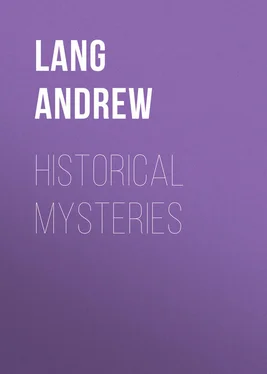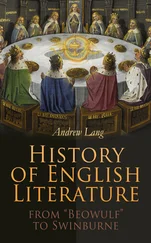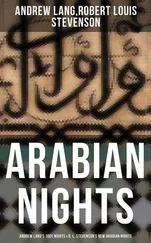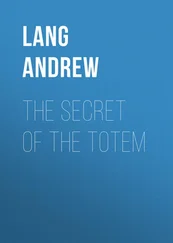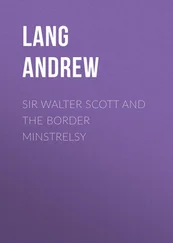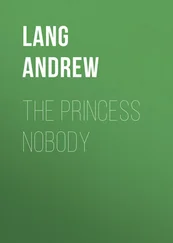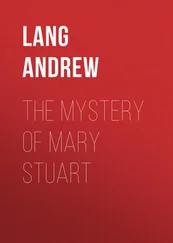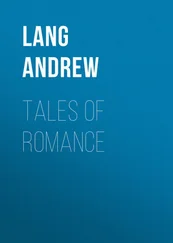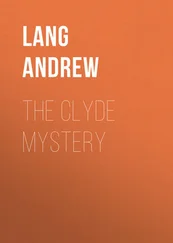Andrew Lang - Historical Mysteries
Здесь есть возможность читать онлайн «Andrew Lang - Historical Mysteries» — ознакомительный отрывок электронной книги совершенно бесплатно, а после прочтения отрывка купить полную версию. В некоторых случаях можно слушать аудио, скачать через торрент в формате fb2 и присутствует краткое содержание. Жанр: foreign_antique, foreign_prose, на английском языке. Описание произведения, (предисловие) а так же отзывы посетителей доступны на портале библиотеки ЛибКат.
- Название:Historical Mysteries
- Автор:
- Жанр:
- Год:неизвестен
- ISBN:нет данных
- Рейтинг книги:5 / 5. Голосов: 1
-
Избранное:Добавить в избранное
- Отзывы:
-
Ваша оценка:
- 100
- 1
- 2
- 3
- 4
- 5
Historical Mysteries: краткое содержание, описание и аннотация
Предлагаем к чтению аннотацию, описание, краткое содержание или предисловие (зависит от того, что написал сам автор книги «Historical Mysteries»). Если вы не нашли необходимую информацию о книге — напишите в комментариях, мы постараемся отыскать её.
Historical Mysteries — читать онлайн ознакомительный отрывок
Ниже представлен текст книги, разбитый по страницам. Система сохранения места последней прочитанной страницы, позволяет с удобством читать онлайн бесплатно книгу «Historical Mysteries», без необходимости каждый раз заново искать на чём Вы остановились. Поставьте закладку, и сможете в любой момент перейти на страницу, на которой закончили чтение.
Интервал:
Закладка:
The girl told her story; but what did she tell? Mr. Austin Dobson, in The Dictionary of National Biography , says that her tale 'gradually took shape under the questions of sympathising neighbours,' and certainly, on some points, she gave affirmative answers to leading questions asked by Robert Scarrat. The difficulty is that the neighbours' accounts of what Elizabeth said in her woful condition were given when the girl was tried for perjury in April-May 1754. We must therefore make allowance for friendly bias and mythopœic memory. On January 31, 1753, Elizabeth made her statement before Alderman Chitty, and the chief count against her is that what she told Chitty did not tally with what the neighbours, in May 1754, swore that she told them when she came home on January 29, 1753. This point is overlooked by Mr. Paget in his essay on the subject. 1 1 Puzzles and Paradoxes , pp. 317-336, Blackwoods, 1874.
On the other hand, by 1754 the town was divided into two factions, believers and disbelievers in Elizabeth; and Chitty was then a disbeliever. Chitty took but a few notes on January 31, 1753. 'I did not make it so distinct as I could wish, not thinking it could be the subject of so much inquiry,' he admitted in 1754. Moreover, the notes which he then produced were not the notes which he made at the time, 'but what I took since from that paper I took then' (January 31, 1753) 'of hers and other persons that were brought before me.' This is not intelligible, and is not satisfactory. If Elizabeth handed in a paper, Chitty should have produced it in 1754. If he took notes of the evidence, why did he not produce the original notes?
These notes, made when, and from what source, is vague, bear that Elizabeth's tale was this: At a dead wall by Bedlam, in Moorfields, about ten p. m., on January 1, 1753, two men stripped her of gown, apron, and hat, robbed her of thirteen shillings and sixpence, 'struck her, stunned her, and pushed her along Bishopsgate Street.' She lost consciousness – one of her 'fits' – and recovered herself (near Enfield Wash). Here she was taken to a house, later said to be 'Mother Wells's,' where 'several persons' were. Chitty, unluckily, does not say what sort of persons, and on that point all turns. She was asked 'to do as they did,' 'a woman forced her upstairs into a room, and cut the lace of her stays,' told her there were bread and water in the room, and that her throat would be cut if she came out. The door was locked on her. (There was no lock; the door was merely bolted.) She lived on fragments of a quartern loaf and water ' in a pitcher ,' with the mince-pie bought for her naughty little brother. She escaped about four in the afternoon of January 29. In the room were 'an old stool or two, an old picture over the chimney,' two windows, an old table, and so on. She forced a pane in a window, 'and got out on a small shed of boards or penthouse,' and so slid to the ground. She did not say, the alderman added, that there was any hay in the room. Of bread there were 'four or five' or 'five or six pieces.' ' She never mentioned the name of Wells. ' Some one else did that at a venture. 'She said she could tell nothing of the woman's name.' The alderman issued a warrant against this Mrs. Wells, apparently on newspaper suggestion.
The chief points against Elizabeth were that, when Wells's place was examined, there was no penthouse to aid an escape, and no old picture. But, under a wretched kind of bed, supporting the thing, was a picture, on wood, of a Crown. Madam Wells had at one time used this loyal emblem as a sign, she keeping a very ill-famed house of call. But, in December 1745, when certain Highland and Lowland gentlemen were accompanying bonny Prince Charlie towards the metropolis, Mrs. Wells removed into a room the picture of the Crown, as being apt to cause political emotions. This sign may have been 'the old picture.' As to hay, there was hay in the room later searched; but penthouse there was none.
That is the worst point in the alderman's notes, of whatever value these enigmatic documents may be held.
One Nash, butler to the Goldsmiths' Company, was present at the examination before Chitty on January 31, 1753. He averred, in May 1754, what Chitty did not, that Elizabeth spoke of the place of her imprisonment as 'a little, square, darkish room,' with 'a few old pictures.' Here the one old picture of the notes is better evidence, if the notes are evidence, than Nash's memory. But I find that he was harping on 'a few old pictures' as early as March 1753. Elizabeth said she hurt her ear in getting out of the window, and, in fact, it was freshly cut and bleeding when she arrived at home.
All this of Nash is, so far, the better evidence, as next day, February 1, 1753, when a most tumultuous popular investigation of the supposed house of captivity was made, he says that he and others, finding the dungeon not to be square, small, and darkish, but a long, narrow slit of a loft, half full of hay, expressed disbelief. Yet it was proved that he went on suggesting to Lyon, Elizabeth's master, that people should give money to Elizabeth, and 'wished him success.' The proof was a letter of his, dated February 10, 1753. Also, Nash, and two like-minded friends, hearing Elizabeth perjure herself, as they thought, at the trial of Mrs. Wells (whom Elizabeth never mentioned to Chitty), did not give evidence against her – on the most absurdly flimsy excuses. One man was so horrified that, in place of denouncing the perjury, he fled incontinent! Another went to a dinner, and Nash to Goldsmiths' Hall, to his duties as butler. Such was then the vigour of their scepticism.
On the other hand, at the trial in 1754 the neighbours reported Elizabeth's tale as told on the night when she came home, more dead than alive. Mrs. Myers had known Elizabeth for eleven years, 'a very sober, honest girl as any in England.' Mrs. Myers found her livid, her fingers 'stood crooked;' Mrs. Canning, Mrs. Woodward, and Polly Lyon were then present, and Mrs. Myers knelt beside Elizabeth to hear her story. It was as Chitty gave it, till the point where she was carried into a house. The 'several persons' there, she said, were 'an elderly woman and two young ones.' Her stays were cut by the old woman. She was then thrust upstairs into a room, wherein was hay , a pitcher of water , and bread in pieces. Bread may have been brought in, water too, while she slept, a point never noted in the trials. She 'heard the name of Mother Wills, or Wells, mentioned.'
Now Scarrat, in 1754, said that he, being present on January 29, 1753, and hearing of the house, 'offered to bet a guinea to a farthing that it was Mother Wells's.' But Mrs. Myers believed that Elizabeth had mentioned hearing that name earlier; and Mrs. Myers must have heard Scarrat, if he suggested it, before Elizabeth named it. The point is uncertain.
Mrs. Woodward was in Mrs. Canning's room a quarter of an hour after Elizabeth's arrival. The girl said she was almost starved to death in a house on the Hertfordshire road, which she knew by seeing the Hertford coach, with which she was familiar, go by. The woman who cut her stays was 'a tall, black, swarthy woman.' Scarrat said 'that was not Mrs. Wells,' which was fair on Scarrat's part. Elizabeth described the two young women as being one fair, the other dark; so Scarrat swore. Wintlebury, her old master, and several others corroborated.
If these accounts by Mrs. Myers, Mrs. Woodward, Scarrat, Wintlebury, and others are trustworthy, then Elizabeth Canning's narrative is true, for she found the two girls, the tall, swarthy woman, the hay, and the broken water-pitcher, and almost everything else that she had mentioned on January 29, at Mother Wells's house when it was visited on February 1. But we must remember that most accounts of what Elizabeth said on January 29 and on January 31 are fifteen months after date, and are biassed on both sides.
Читать дальшеИнтервал:
Закладка:
Похожие книги на «Historical Mysteries»
Представляем Вашему вниманию похожие книги на «Historical Mysteries» списком для выбора. Мы отобрали схожую по названию и смыслу литературу в надежде предоставить читателям больше вариантов отыскать новые, интересные, ещё непрочитанные произведения.
Обсуждение, отзывы о книге «Historical Mysteries» и просто собственные мнения читателей. Оставьте ваши комментарии, напишите, что Вы думаете о произведении, его смысле или главных героях. Укажите что конкретно понравилось, а что нет, и почему Вы так считаете.
